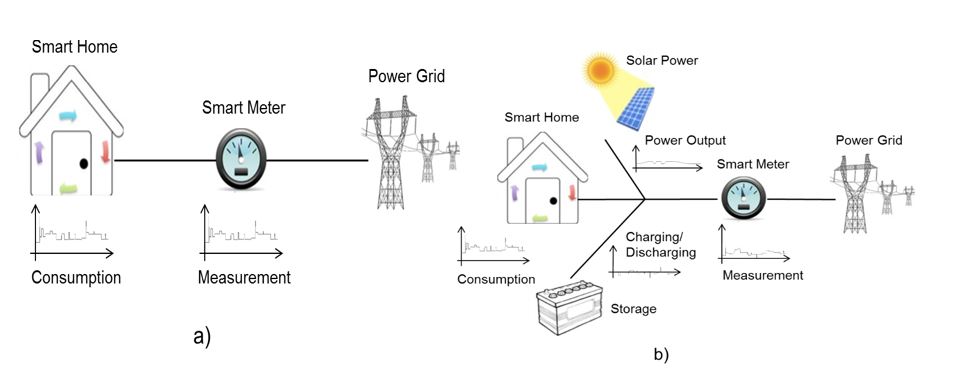Energy Storage for Smart Meter Privacy
An energy storage system (e.g., a battery) that changes the consumption pattern reported to the electric utility, using a predetermined pattern formed by an algorithm. Our aim is to study and develop the technology of a physical approach to enhance user privacy.

Background
Smart meters (SM) are needed in the modern power grid for many reasons. They made it possible for a two-way communication between user and electric utility, and they facilitate modern smart services such as financial plans for the user, distributed renewable energy and grid status. However, in essence, the power consumption profile data also contains privacy-sensitive information of the user. In particular, the profile data reveals the usage behaviour of appliances that enable exhaustive conclusions on one’s private life.
The consumption that is reported to the electric utility by the SM is a pattern that cannot be easily identified. For the design of efficient energy control algorithms, however, we need real energy consumption data and, additionally, reference data which includes the “ground truth,” i.e., data that describes the true usages of appliances.
Project description
This project aims to collect a dataset from smart electricity meters connected to the student apartments in the testbed at KTH Live-In Lab. We will then make the dataset available to other research groups to contribute to research that can lead to reduced energy consumption, and thereby helping to achieve the climate goals.
Based on the collected dataset, we aim to investigate how using the battery as an intermediary between the tenant and the electricity supplier can help to optimize the electricity usage, and raise the tenants’ awareness of their energy consumption, thus, making it easier to reduce. Furthermore, with a smart electricity meter coupled to the battery that changes the tenant’s consumption pattern through an algorithm, we can protect the personal integrity, while maintaining a high optimization rate in terms of energy use.
In this project, we will develop a method where a battery in a household is charged during periods of the day when the total load on the power line is low. The primary profit is that the personal privacy will be protected by using household energy from the battery, and by that making the household’s real energy consumption pattern unavailable to the electricity supplier. As a secondary profit, we will create an open data solution to make the data accessible to other research groups, so that they can use the data in their studies even without having the resources to do their own measurements.
Project implementation
There will be two measurement campaigns implemented in the KTH Live-In Lab. In both we will collect the smart meter readings and the power usage data of four apartments over a period of one year.
The first measurement campaign will be used to create a reference dataset, and made publicly available for research, e.g., testing algorithms in simulations. In the second measurement campaign we will test an energy storage system and power-flow algorithms to evaluate their suitability to alter the, by the SM reported, power flow for the consumer and therewith the enhancement of their privacy.
More appliance data available will result in a more annotated dataset making the reference dataset more valuable for privacy-enhancement technology performance assessments. This means that as more true background information of the situation is available, the more numerical experiments can be performed. The database will contain time series data of the power usage in the apartments (i.e., current measurement).
Appliances that reveal usage behaviour will be the most informative on the personal behaviour. Standard disaggregation algorithms will first identify large energy consumers (e.g., fridge, oven, kettle), which are then cancelled from the smart meter profile. From the remaining profile we will be able to infer about specific appliances.
The datasets will be made publicly available to enable re-use of the data and verification of research results. Access to the data will be provided after completing an online registration form requesting the purpose and a valid e-mail address. The data will then be made available under the “Creative Commons License” (BY-SA, Attribution).
